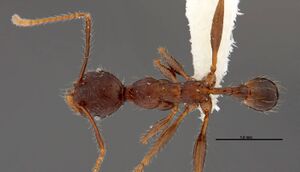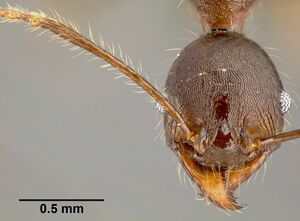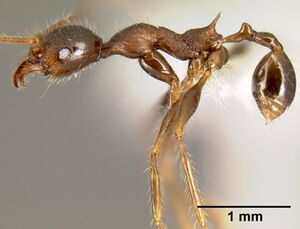Pheidole lagunculinoda
| Pheidole lagunculinoda | |
|---|---|

| |
| Scientific classification | |
| Kingdom: | Animalia |
| Phylum: | Arthropoda |
| Class: | Insecta |
| Order: | Hymenoptera |
| Family: | Formicidae |
| Subfamily: | Myrmicinae |
| Tribe: | Attini |
| Genus: | Pheidole |
| Species: | P. lagunculinoda |
| Binomial name | |
| Pheidole lagunculinoda Longino, 2009 | |
This species occurs in lowland to mid-elevation wet forest. Minor workers have been collected at baits. One major worker has been collected, at a bait along with minor workers.
Identification
With a unique morphometric profile. Minor worker: the most distinctive character is the postpetiole, which is much longer than wide in dorsal view and flask-shaped. The postpetiole shape combined with large size and foveolate face should distinguish it from all other species. Major worker: head subrectangular versus with sides more convex and posterior margin more cordate (Pheidole bulliceps, Pheidole galba, Pheidole gigas, Pheidole hirsuta, Pheidole huacana); vertex lobes foveolate overlain by reticulate rugulae versus with arcing subparallel rugae (Pheidole arcifera, Pheidole rhea) or relatively smooth and shining (Pheidole astur, Pheidole auropilosa, Pheidole bergi, Pheidole geraesensis, huacana, Pheidole oxyops, Pheidole trageri); base of scape terete versus flattened (Pheidole claviscapa); propodeal spines long versus short (Pheidole tigris, trageri); first gastral tergite shallowly foveolate anteriorly, grading to smooth and shining posteriorly, versus more uniformly foveolate, opaque (Pheidole vorax). (Longino 2009)
Distribution
Latitudinal Distribution Pattern
Latitudinal Range: 17.51427° to 16.9562841°.
| North Temperate |
North Subtropical |
Tropical | South Subtropical |
South Temperate |
- Source: AntMaps
Distribution based on Regional Taxon Lists
Neotropical Region: Guatemala, Mexico (type locality).
Distribution based on AntMaps
Distribution based on AntWeb specimens
Check data from AntWeb
Countries Occupied
| Number of countries occupied by this species based on AntWiki Regional Taxon Lists. In general, fewer countries occupied indicates a narrower range, while more countries indicates a more widespread species. |

|
Estimated Abundance
| Relative abundance based on number of AntMaps records per species (this species within the purple bar). Fewer records (to the left) indicates a less abundant/encountered species while more records (to the right) indicates more abundant/encountered species. |

|
Biology
Castes
Worker
Minor
Images from AntWeb
   
| |
| Paratype Pheidole lagunculinoda. Worker. Specimen code casent0609857. Photographer Erin Prado, uploaded by California Academy of Sciences. | Owned by CAS. |
   
| |
| Paratype Pheidole lagunculinoda. Worker. Specimen code casent0609877. Photographer Stephanie Ware, uploaded by Field Museum. | Owned by FMNH. |
    
| |
| Holotype Pheidole lagunculinoda. Worker. Specimen code casent0609878. Photographer John T. Longino, uploaded by California Academy of Sciences. | Owned by UNAM. |
Major
Images from AntWeb

| |
| Paratype Pheidole lagunculinoda. Worker (major/soldier). Specimen code casent0609553. Photographer John T. Longino, uploaded by California Academy of Sciences. | Owned by MCZ. |
Nomenclature
The following information is derived from Barry Bolton's Online Catalogue of the Ants of the World.
- lagunculinoda. Pheidole lagunculinoda Longino, 2009: 48, fig. 12 (s.w.) MEXICO.
Unless otherwise noted the text for the remainder of this section is reported from the publication that includes the original description.
Description
Worker
Minor Measurements (holotype): HL 0.87, HW 0.73, HLA 0.34, SL 1.20, EL 0.15, ML 1.25, PSL 0.20, PMG 0.01, SPL 0.04, PTW 0.13, PPW 0.23, CI 84, SI 164, PSLI 24, PMGI 1, SPLI 4, PPI 182.
Measurements (n=10): HL 0.82-0.90, HW 0.72-0.80, SL 1.10-1.28, CI 84-89, SI 152-167.
Mandible longitudinally striate basally, grading to smooth and shining near masticatory margin; clypeus weakly foveolate rugulose; face shallowly foveolate; margin of vertex rounded; occipital carina well developed as a distinct flange, visible in full face view; scape with abundant erect setae, longest subequal in length to maximum width of scape; promesonotal groove weakly impressed, indistinct; propodeal spines present, long; entire mesosoma foveolate, overlain with weak transverse rugulae on promesonotal dorsum; abundant setae on promesonotal dorsum; dorsal (outer) margin of hind tibia with abundant erect setae, longest longer than maximum width of tibia; postpetiole in dorsal view much longer than wide, flask-shaped, tapering anteriorly; first gastral tergum smooth and shining; gastral dorsum with abundant erect setae; color brown.
Major Measurements (paratype): HL 2.31, HW 2.16, HLA 0.59, SL 1.16, EL 0.25, ML 1.76, PSL 0.30, PMG 0.04, SPL 0.07, PTW 0.32, PPW 0.66, IHT 0.42, OHT 0.95, CI 93, SI 54, PSLI 13, PMGI 2, SPLI 3, PPI 205, HTI 44.
Mandible with coarse longitudinal striae basally, grading to smooth and shining over most of dorsal surface, dorsal surface with medium density of large puncta, puncta lacking setae (or with very short appressed setae) over most of dorsal surface; clypeus shining, with median carinule, 3-4 longitudinal carinules beneath each frontal carina, weakly wrinkled elsewhere; entire face foveolate overlain by reticulate rugulae, rugulae becoming coarser and more longitudinally parallel anteriorly and between frontal carinae; scrobe absent; basal half of scape strongly curved, scape terete, irregularly rugulose, with abundant erect setae longer than maximum width of scape; hypostomal margin flat; median tooth a broad gibbosity; inner hypostomal teeth stout, closer to midline than to outer hypostomal teeth; with abundant erect setae projecting from sides of head in full face view; promesonotal groove present; propodeal spines present; mesosoma shallowly foveolate overlain with reticulate rugulae; dorsal (outer) margin of hind tibia with abundant erect setae longer than maximum width of tibia; pilosity abundant on mesosomal dorsum; postpetiole in dorsal view transverse, with strongly-developed lateral conules; first gastral tergite shallowly foveolate anteriorly, grading to smooth and shining posteriorly, with abundant flexuous erect setae; color brown.
Type Material
Holotype minor worker. Mexico, Chiapas: 21km SW Salto de Agua, 17.38542°N 92.42802°W, ±200m, 180m, 15 Jun 2008 (LLAMA#Ba-A-08-4-03-17) UNAM, unique specimen identifier CASENT0609878.
Paratypes: major and minor workers. Same data as holotype; same data as holotype but LLAMA#Ba-A-08-3-02-16, Ba-A-08-4-03-08; Mexico, Chiapas: 8km SE Salto de Agua, 17.51427°N 92.29486°W, ±200m, 70m, 16 Jun 2008 (LLAMA#Ba-A-08-1-01-13, Ba-A-08-1-02-02, -11, -17, -19) The Natural History Museum, California Academy of Sciences, EAPZ, Field Museum of Natural History, Instituto Nacional de Biodiversidad, John T. Longino Collection, Los Angeles County Museum of Natural History, Museum of Comparative Zoology, Musee d'Histoire Naturelle Genève, Instituto de Zoologia Agricola, Museu de Zoologia da Universidade de Sao Paulo, University of California, Davis, ICN, National Museum of Natural History.
Etymology
The name is in reference to the elongate, flask-shaped postpetiole.
References
- Longino, J.T. 2009. Additions to the taxonomy of New World Pheidole. Zootaxa 2181: 1-90. PDF
References based on Global Ant Biodiversity Informatics
- Dattilo W. et al. 2019. MEXICO ANTS: incidence and abundance along the Nearctic-Neotropical interface. Ecology https://doi.org/10.1002/ecy.2944
- Vásquez-Bolaños M. 2011. Lista de especies de hormigas (Hymenoptera: Formicidae) para México. Dugesiana 18: 95-133

